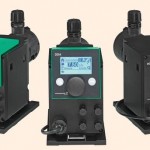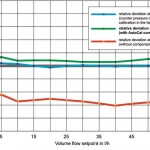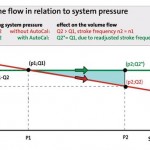Dosing is a key component of chemical, process and water treatment technology. Highly effective chemicals must be added economically, accurately and without environmental impact – something that requires precision. Smart digital dosing pumps meet these challenges: they do the dosing using the latest drive technology with uniform precision and offer a high handling standard as well as an intelligent FlowControl system.
The author: Matthias Ulmer Product Manager Dosing Technology, Grundfos
For traditional dosing pumps, the metered quantities are set by changing the stroke length or the stroke frequency. In practice, however, calculating the setting parameters such as stroke rate, stroke length, stroke volume and stroke frequency, is expensive and error-prone. If the stroke length is too short, air bubbles or faults in the intake can result. If the stroke frequency is low and dosing is switched on and off, this leads to interruptions in the metered flow and prevents continuous dosing. The digital dosing principle developed by Grundfos eliminates such problems. The use of stepper motors or EC drives gives the operator precise control over the stroke rate. The duration of each compression stroke varies according to the selected dose rate. The suction stroke is constant, but it can be extended by the anti-cavitation function and thus adapted to the requirements.
The key advantage is that the suction stroke always utilises the full stroke volume. This facilitates continuous dosing and reduced pulsation – important factors for trouble-free pumping of gassing media or for installations requiring long suction lines.
By using a stepper motor, the dose rate is varied by altering the rate of the pressure stroke and the full stroke length is leveraged throughout.
Continuous dosing offers clear advantages, especially for metering very small quantities (e. g. antiscalant metering during reverse osmosis).
The digital dosing pumps have a maximum adjustment range of 1:3000 (which is thirty times larger than that of conventional metering pumps!). A single model covers the range from 0.0025 to 7.5 l/h, for example, meaning a smaller spare parts inventory, more storage capacity and greater operational flexibility for users.
The fact that the dosing performance is entered digitally without having to adjust the stroke, in combination with a calibration function to match the metered medium, the positive drive of the membrane and the optimised dosing head and valve geometry, translates into a very high precision of ± 1 % for the diaphragm pumps.
Easy to handle and control
Thanks to the rotary click wheel and the intuitive user interface in over 25 languages on a graphic LC display, the smart digital dosing pumps are very easy to operate. The desired dose rate can be entered on the display directly in ml/h, l/h or gph. The large LCD screen provides valuable information about the status of the pump, even at a distance. If the screen is green, the pump is running and everything is fine. If an error occurs, e. g. if there is an empty message, the display changes to yellow (warning) or is backlit in red in case of an alarm; white indicates that the pump has stopped. In addition, the pumps have a universal mounting plate that can be used to install any stand-ard model. They can be separated from the mounting plate again quickly and easily by means of the click function if necessary.
Intelligent flow control
When the intelligent FlowControl system was developed, the focus was on process reliability. Even if the process conditions change, e. g. due to fluctuations in system pressure, unwanted interruptions, under- or over-dosage and dangerous situations such as leakage or a line break are detected and prevented. With its well-defined membrane positions, the digital drive technology allows the pressure – and therefore the dose rate – to be displayed and diagnosed accurately as a function of time via a pressure sensor in the dosing head. Deviations from the norm result in an error-specific change in the pressure curve. All the most common faults occurring during dosing with diaphragm pumps are therefore diagnosed reliably. These faults are displayed in plain text in the Alarm menu and the pump responds with a warning or an alarm (= stop). If the pressure drops, e. g. on account of a line break, or exceeds a freely selectable value, the pump switches off automatically so that critical situations caused by the leakage of chemicals are ruled out.
Furthermore, the Auto-FlowAdapt function ensures that the dosing process provides the required volume flow continuously, even in the presence of external influences. For example, if gassing media are dispensed automatically after detecting air bubbles, the motor is controlled in such a way that the bubbles can escape from the dosing head. Variations in system pressure likewise have no influence on the flow rate – deviations are automatically compensated for by adjusting the speed of the stepper motor. The integrated flow measurement means that no additional instruments are needed. The actual flow rate is shown directly on the display and can also be transmitted to the control panel via the analogue output or the bus protocol if necessary.
Fieldbus connection
There are different ways to supply the data from a field device (in this case, the dosing pump) to the central control panel. The traditional method is to wire each individual device to a central process controller. This works fine but is not very efficient. However, the use of a bus structure makes point-to-point wiring unnecessary. In practice, this cuts the installation costs of field devices by up to 40 %. Moreover, it allows new devices to be integrated into the system very easily by connecting them to the bus. The option of connecting to the central control system via a fieldbus gives the operator of a dosing pump several efficient options for effective monitoring, supervision and control. All data generated is then additionally available for preventive maintenance and repairs, for instance. Last but not least, the data can be archived. This is important, amongst other things in industries with strict FDA (Food and Drug Administration) requirements for the U.S.
Online-Info: www.cpp-net.com/2211420
Share:









